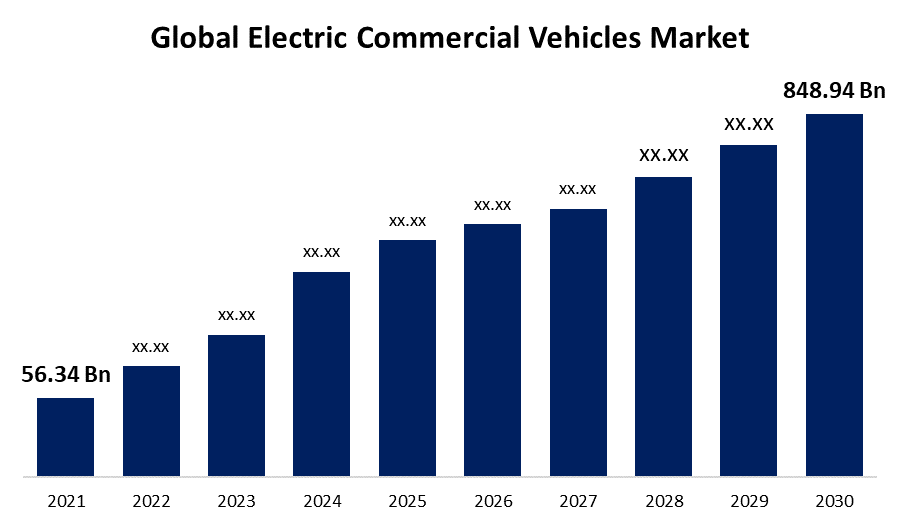Global Electric Commercial Vehicles Market Size to grow USD 848.94 Billion by 2030 | CAGR of 34.4%
Category: Automotive & TransportationGlobal Electric Commercial Vehicles Market is Anticipated to Grow at a CAGR of 34.4% from 2021 to 2030
The Global Electric Commercial Vehicles Market size was valued at USD 56.34 Billion in 2021, the market is projected to grow USD 848.94 Billion in 2030, at a CAGR of 34.4%. as per the latest research report by Spherical Insights & Consulting.

Get more details on this report -
An electric commercial vehicle can run on electricity either totally or partially in place of diesel or gasoline. Since they have fewer moving parts to maintain and consume little to no fossil fuels, electric commercial vehicles are also incredibly cost-effective to operate (petrol or diesel). Fleets of vehicles powered by renewable resources are the new trend for governmental authorities, non-profit organisations, and many private firms encouraging sustainable development. Over the past few years, initiatives for technological advances and innovation in transportation have increased.
Browse key industry insights spread across 200 pages with 122 market data tables and figures & charts from the report” Global Electric Commercial Vehicles Market Size, Share & Trends, Covid-19 Impact Analysis Report, By Product ( Light Commercial Vehicles (LCVs), Buses & Coaches, and Heavy Trucks) By End-user (Mining & Construction, Industrial, Passenger Transportation, Logistics, and Others) By Propulsion Type ( IC Engine, Electric Vehicle) By Power Source (Gasoline, Diesel, HEV / PHEV, Battery Electric Vehicle (BEV), Fuel Cell Vehicle) By Region (North America, Europe, Asia Pacific, Middle East & Africa, and South America), Analysis And Forecast 2021 – 2030 “in detail along with the table of contents. https://www.sphericalinsights.com/reports/electric-commercial-vehicles-market
As technology takes root and customer expectations alter, logistics industries are experiencing an era of unparalleled upheaval. A higher level of efficiency and more collaborative operating models are now possible thanks to new technological technology. As a result, it is predicted to have a significant impact on the market for electric commercial vehicles. A increasing number of low-value shipments have been made as a result of the expansion of e-commerce. In response, retailers are setting up "last-mile" fulfilment centres to maintain inventory near to customers and decentralising their distribution centres more and more. The need for electric commercial trucks to move inventory to nearby distribution hubs without emitting any emissions rises as a result of this.
When compared to conventional ICE-powered commercial vehicles, electric commercial vehicles have significantly lower maintenance expenses since they have fewer moving parts and need fewer fluid changes, which lowers the cost of repair and replacement. Brushless induction motors and batteries are replacing engines, transmissions, and exhaust systems since they require no maintenance. This, along with cheaper insurance costs resulting from the vehicle's greater safety standards, are some of the elements that lower the operating expenses of electric commercial vehicles.
Commercial electric vehicles are becoming more and more in demand. The adoption is being hampered by the need for a highly skilled personnel to maintain these cars as well as the relatively new electric commercial vehicle technology. However, it is anticipated that the impact of these limiting constraints would be reduced by the creation of an infrastructure for supporting electric commercial cars and quick technological improvements. As a result, over the course of the forecast period, it is anticipated that the influence of electric commercial cars' low operating costs would increase.
Although the price of batteries has lately come down, manufacturers of electric commercial vehicles are still having difficulty developing a trustworthy and affordable alternative to ICE commercial vehicles in the majority of applications. The need to replace the battery every one to two years places further restrictions on the use of electric commercial vehicles. Electric commercial vehicles' slow market uptake has also been hampered by safety and security issues related to battery explosion in harsh operating conditions and weather.
Covid 19 Impact on Global Electric Commercial Vehicles Market
Due to the new coronavirus's continuous global spread, automakers are taking extreme measures, such as halting plants, to stop the disease. The situation is still unclear as more European companies cease operations and US and APAC manufacturers extend shutdown durations. Travel, social interaction, and attendance at work in various locations are subject to limitations that appear to be getting tougher and stricter from the governments of the countries. This discontent, which is obstructing the advancement of the global electric commercial vehicle, is centred on the automobile industry. Similar issues are being experienced in several areas, which is having a notable effect on both the economy and society and causing significant economic upheaval.
Global Electric Commercial Vehicles Market, By Product
Due to its growing use in the healthcare and tourist sectors, the buses and coaches segment is anticipated to gain traction throughout the course of the analysis period. The most economical means of transportation, buses have a beneficial impact on their sales in the global electric commercial vehicle industry. Additionally, governments in various regions have heavily embraced green mobility, swiftly replacing conventional buses and other forms of public transportation with smart and electric-powered vehicles that considerably contribute to the segment's growth.
Global Electric Commercial Vehicles Market, By Propulsion Type
In terms of revenue share, the IC engine dominates the market for electric commercial vehicles, while electric vehicles are anticipated to grow at the fastest rate during the estimated period. The rapid growth of the commercial vehicle market in this region is partly attributable to government initiatives to encourage the use of electric vehicles in all industries. Additionally, the ecologically friendly attributes of electric cars contribute to a decrease in pollution levels across the country.
Global Electric Commercial Vehicles Market, By End Use
Due to the expansion of trade operations globally during the last few years, the logistics market has seen significant demand. Additionally, the category recorded a notable revenue share in 2021 as a result of increased e-commerce and retail company penetration. The e-commerce industry has expanded greatly as a result of changing consumer trends for online shopping, which has in turn boosted the market growth for the logistics segment.
Global Electric Commercial Vehicles Market, By Region

Get more details on this report -
During the forecast period, Asia Pacific is anticipated to experience the fastest growth rate. Rapid urbanisation, industrialisation, a sizable population, and strong government investments in the construction of cutting-edge infrastructure are all present in Asia Pacific. Due to the large number of industries in the area, there is now a much higher demand for commercial vehicles to transport goods both domestically and internationally. Additionally, China is a major global producer and consumer of electric vehicles.
Some Recent Developments in Global Electric Commercial Vehicles Market
- May 2021: Solaris, a CAF Group subsidiary, signed a contract with the Transports Metropolitans de Barcelona (TMB) to provide 30 Urbino 12 hybrid buses in order to expand the fleet of vehicles operating in the Barcelona Metropolitan Area.
- May 2021: Through a collaboration with global logistics service provider DB Schenker, FUSO, a Daimler Trucks brand, became the largest electric fleet customer with 41 eCanter currently in daily use.
Segmentation
By Product
- Light Commercial Vehicles (LCVs)
- Buses & Coaches
- Heavy Trucks
By End-use
- Mining & Construction
- Industrial
- Passenger Transportation
- Logistics
- Others
By Propulsion Type
- IC Engine
- Electric Vehicle
By Region
By Region
- North America
- U.S.
- Canada
- Europe
- U.K.
- Germany
- France
- Asia Pacific
- China
- India
- Japan
- South Korea
- Middle East & Africa
- South America
Related Report:
Global Electric Bus Market Size, Share, Analysis Forecast 2030
Global E-bike Market Size, Share, Statistics Analysis Research Report By 2030
Contact Us: https://www.sphericalinsights.com/contact-us
Need help to buy this report?